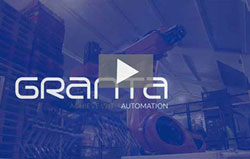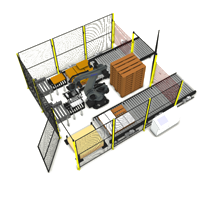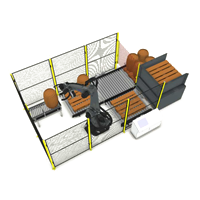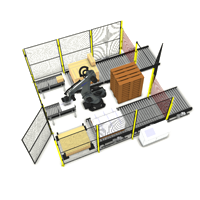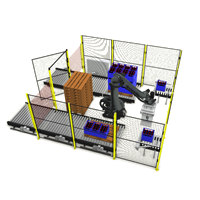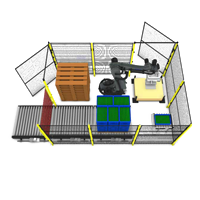In many warehouses and production facilities across the UK and beyond, manual palletising is a daily reality—one that seems simple on the surface but leads to a surprising number of operational challenges. What often begins as a quick fix for moving finished goods onto pallets becomes a source of labour inefficiencies, quality control issues, and rising injury rates.
If you’re reading this, there’s a good chance you’re not searching for ‘automated palletisers.’ What you’re actually looking for is a better way to deal with:
- Increasing palletising labour problems
- Constant pallet loading issues
- Growing concerns over worker fatigue and injuries
- A desire to reduce palletising errors
- Concerns about safety, compliance, and long-term sustainability
You’re not alone. These are the exact triggers that prompt most of our clients to reach out to Granta Automation. Not because they’re desperate for a robot—but because the traditional way of doing things just isn’t cutting it anymore.
Let’s take a closer look at why this happens, what the true costs are, and what a smarter path forward might look like.
The True Cost of Manual Palletising
It’s easy to assume that manual palletising is the cheapest option. You have the workforce already. A few training sessions and a pallet truck—job done, right?
Not quite.
Over time, businesses that rely on manual palletising begin to experience a range of persistent and costly challenges:
- Worker Fatigue and Reduced Productivity
Palletising is repetitive, physically demanding work. Stacking dozens—or hundreds—of heavy items every shift leads to muscle strain, exhaustion, and slower output as the day progresses. By the end of a shift, error rates climb and motivation drops. - Staff Turnover and Labour Shortages
It’s increasingly hard to find and retain people willing to do hard manual labour, especially in competitive job markets. The result? High turnover, frequent recruitment, and training cycles that drain your time and budget. - Palletising Safety Concerns
From back injuries to slips and falls, the health and safety risks associated with manual palletising are serious. Just one incident can lead to long-term absence, HSE investigations, or even litigation. - Inconsistent Pallet Quality
Humans aren’t machines. Manual palletising leads to stacks that are often uneven or improperly aligned—especially when operators are rushing to keep up. Poorly stacked pallets increase the risk of product damage during transit or storage. - Hidden Time and Cost Drains
Even small delays add up—pauses for rest, adjusting misaligned boxes, or resolving damaged product complaints. Over a week, month, or year, these inefficiencies significantly slow down throughput and increase costs.
The Limits of “Fixing” Manual Systems
When businesses first encounter these challenges, the instinct is to tweak the existing process rather than overhaul it. Common responses include:
- Rotating palletising tasks between workers
- Investing in lifting aids and ergonomic supports
- Redesigning the palletising area to be more efficient
- Hiring additional labour during peak periods
- Offering overtime to boost output
While these can provide short-term relief, they don’t solve the core problem: manual palletising is inherently limited by human capability.
Even under ideal conditions, it’s difficult to sustain quality, speed, and safety with manual stacking. And when volume spikes—or when staff call in sick—the cracks begin to show.
The Power of Automated Palletising: Solving Problems at the Source
A well-designed automated palletiser transforms the palletising process from a physical burden into a seamless, consistent, and safe operation. Here’s how:
- Eliminate Manual Handling Risks
Workers no longer need to lift, twist, or stack heavy items—dramatically reducing the risk of musculoskeletal disorders and fatigue-related errors. - Ensure Consistency, Every Time
Robotic systems follow programmed patterns precisely, producing uniform, stable pallets that reduce damage during transport and improve stacking efficiency in storage. - Boost Throughput Without Additional Labour
Once configured, automated palletisers can operate continuously, at speeds far beyond what human workers can sustain—even running 24/7 with no supervision. - Reallocate Labour to Higher-Value Tasks
Staff who were previously stuck doing repetitive palletising can be trained to supervise systems, manage logistics, or focus on quality control—improving job satisfaction and productivity. - Rapid Return on Investment
Despite initial capital costs, most businesses experience ROI in 6 to 24 months, especially when factoring in savings on labour, reduced injuries, improved throughput, and fewer rejected loads.
Tailored Solutions: Not One-Size-Fits-All
At Granta Automation, we don’t believe in off-the-shelf fixes. Every business is different—different products, different stacking requirements, different floor layouts. That’s why every palletising system we deliver is fully tailored and;
- Specified for your specific product dimensions, weights, and packaging types
- Designed to work within your available space and production flow
- Configured to suit your pallet patterns and loading sequences
- Scalable to grow with your operation over time
We work with you from day one to understand your process, goals, and constraints—delivering a solution that doesn’t just work, but fits your business like a glove.
Concerned About Cost? Let’s Talk Numbers
We understand the hesitation: automation is a big step. But when we work out the numbers with our clients, the case becomes clear. Most systems we install pay for themselves within 12–18 months, thanks to:
- Labour cost reductions
- Decreased product damage
- Lower injury and insurance claims
- Increased output and consistency
- Reduced downtime and staffing issues
If you’re not ready for this initial capital outlay, our palletising systems can be hired from just £2.19/hour.
We offer detailed ROI calculators and live demonstrations so you can see how it would work—before you make any decisions.
Ready to Explore What Automation Could Look Like For You?
Here’s what the first step looks like:
- Step 1: Free Palletising Process Audit
We assess your current process and determine if automation is viable. - Step 2: Custom ROI Report
We give you a breakdown of cost, potential savings, and expected payback period—based on your real-world data. - Step 3: System Proposal and Timeline
If it’s a good fit, we outline exactly what your tailored system would include, along with installation timelines and training support.
There’s no obligation, and no pressure—just a clear path forward. At Granta Automation, we’re here to help you transition from reactive problem-solving to proactive improvement.
Book your free palletising audit today
Let’s solve the problems you’re already dealing with—and discover the performance you didn’t think was possible. Contact us today on 01223 499488 or helpline@granta-automation.co.uk,
Find out more…
- Grantas Portable Cobot Palletising System: High-Performance Automation That Moves With You
- Manual vs. Automatic Palletising: A Comprehensive Comparison
- Manufacturing Efficiency: Why Every Second (and Every Pound) Counts
- The Hidden Costs of Downtime in Food & Beverage Production
- How Robotic Palletisers Deliver Fast ROI for Manufacturers


